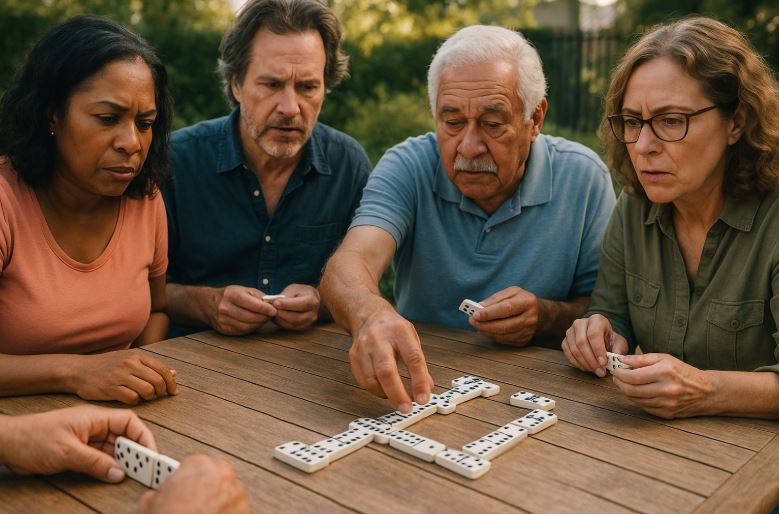How to Play Dominoes? | A Beginner’s Step-by-Step Guide
Everyone remembers the first time they sat around a table with friends or family, staring at a scattered pile of rectangular tiles marked with dots. For many in the UK and across the Caribbean, playing dominoes isn’t just a game, it’s a cherished tradition.
My curiosity led me to learn the game during a lively gathering in Brixton. The enthusiasm, banter, and intense concentration over a game of dominoes showed me that it was more than just matching tiles, it was a cultural bond.
For beginners, learning how to play dominoes can seem a bit daunting. But once you grasp the fundamentals, it quickly becomes one of the most enjoyable and intellectually engaging games.
This guide simplifies everything you need to know, from understanding the pieces to playing your first match. Based on authoritative resources and modern 2025 updates, here’s your complete step-by-step journey to mastering dominoes.
What is Dominoes?

Dominoes is a tile-based game with a rich history dating back to China in the 13th century, later evolving in Europe during the 18th century. The game involves rectangular tiles known as dominoes, each divided into two squares, with each half showing a number of pips or a blank.
Today, dominoes is played worldwide in various formats, but its cultural heart beats strongly in communities across the UK, the Caribbean, and Latin America. It’s often associated with social gatherings, where players combine skill, strategy, and a touch of luck.
Key Characteristics of Dominoes
- Typically played by 2 to 4 players
- Each player draws a set number of tiles from a shuffled set
- The game proceeds by matching tiles with the same number of pips
- Objective varies with game type: block opponents, score points, or empty your hand first
What makes Dominoes unique is its dual nature, simple enough for children to learn, yet deep enough to engage experienced players.
What Are the Basic Rules of Dominoes?
Understanding the core rules of dominoes is essential before diving into a game. While rule sets can vary slightly, the basic mechanics stay largely consistent across all types.
Setting Up the Game
Each game starts with all domino tiles placed face down and shuffled. Each player then draws a certain number of tiles, depending on the total number of players and the domino set being used.
In a standard two-player game with a double-six set, each player draws seven tiles. For four players, five tiles per player are drawn. The remaining tiles become the boneyard, a pool of players draw from when they cannot make a move.
The Turn Structure
Gameplay begins with the player holding the highest double tile, commonly double-six. If no player has a double, the tiles are reshuffled. Turns proceed in a clockwise direction, with each player laying a tile that matches one end of the chain on the table.
If a player cannot play, they must draw from the boneyard until they find a playable tile or the boneyard is empty. If no playable tile is found, the player passes.
The game continues until one player empties their hand or all players are blocked from making a move.
What Equipment Do You Need to Play Dominoes?

The equipment for dominoes is minimal, making it accessible and portable. All you really need is a set of domino tiles and a flat surface.
Standard Domino Sets
- Double-Six Set: 28 tiles; most commonly used for casual play
- Double-Nine Set: 55 tiles; allows more players or complex variants
Optional Accessories
- Tile racks for discreet tile holding
- Score sheets for tracking points in scoring games
- Table mats to reduce noise and enhance visibility
Each tile contains two square ends with a number of spots or pips ranging from 0 to 6 or higher, depending on the set. Traditional sets are made of ivory or bone, but modern sets come in plastic, resin, or even wood.
What Are the Different Types of Domino Games?
There’s no single way to play dominoes. The game has evolved into multiple variants, each offering its own flavour and strategy.
Block Game
This is the most straightforward form. Each player draws tiles and plays by matching the open ends of the domino chain. Once a player is unable to make a move, their turn ends without drawing additional tiles.
The game ends when a player plays all their tiles or when the game is blocked. The winner is the one with the lowest total pip count in their hand.
Draw Game
Similar to the block game, but with a key difference: when players cannot play, they must draw tiles from the boneyard. This continues until they find a playable tile or the boneyard is exhausted. It adds more unpredictability and extends the game.
All Fives (Muggins)
In this scoring-based version, players earn points by making the total of the open ends of the domino chain equal to a multiple of five. For example, if you play a tile that causes the ends to sum to 10, you score 10 points.
Caribbean Dominoes
This version is faster, louder, and more social. It’s often played in teams of two. Talking is part of the game, players use subtle signals, body language, and verbal cues to support teammates and outwit opponents. This style values rapid decision-making and sharp memory skills.
How to Play Dominoes? – Step by Step

Let’s walk through a basic game using the double-six set. This is ideal for beginners and forms the foundation for learning other versions.
Step 1: Shuffle and Draw
Place all 28 tiles face down and shuffle. Each player draws seven tiles in a two-player game. In a four-player game, draw five tiles each. The remaining tiles are set aside as the boneyard.
Step 2: Start with the Highest Double
The player who has the highest double tile begins by placing it in the centre of the table. If no doubles are held, reshuffle and redraw until one is found.
Step 3: Take Turns
Players take turns placing tiles that match the exposed ends. For example, if a double six is played first, the next tile must have a six. Only one tile can be played per turn unless otherwise specified in advanced rules.
Step 4: Draw If Needed
If a player cannot play a matching tile, they draw from the boneyard until they can. If the boneyard is empty and they still can’t play, their turn is skipped.
Step 5: Win the Round
The round ends when a player uses all their tiles or no legal moves remain. The winner is determined by who runs out first or who holds the lowest total pip value.
This process can be repeated for multiple rounds, with scores tallied if playing a cumulative format.
How to Play Dominoes with 2 Players?
Playing dominoes with two players is one of the simplest and most engaging formats. It’s ideal for beginners and allows for quick strategic play. Here’s how to get started:
Step 1: Shuffle and Draw Tiles
Lay all 28 domino tiles face down and mix them thoroughly. Each player draws 7 tiles. The remaining 14 tiles form the boneyard (draw pile).
Step 2: Decide Who Starts
The player with the highest double (e.g., double-six) goes first. If neither has a double, tiles are reshuffled and redrawn.
Step 3: Begin the Game
The starting player places their highest double tile in the centre of the playing area. The second player must play a tile that matches one of the open ends.
Step 4: Take Turns
Players alternate turns, placing tiles that match the numbers at either open end of the chain. Only one tile is played per turn.
Step 5: Draw If You Can’t Play
If a player cannot match a tile, they must draw from the boneyard until they get a playable tile. If the boneyard is empty, they pass their turn.
Step 6: End the Game
The game ends when:
- One player plays all their tiles
- Both players are blocked and cannot make a move
Step 7: Scoring
The winner is the player who:
- Plays all their tiles
- Or has the fewest pips (dots) left when the game is blocked
They score points based on the total pips remaining in the opponent’s hand.
How to Play Dominoes with 4 Players?

Four-player dominoes is one of the most popular ways to enjoy the game, especially in social or family settings. You can play individually or in teams of two, with partners sitting opposite each other.
Step 1: Shuffle and Draw Tiles
Mix all 28 tiles face down. Each player draws 5 tiles. The remaining 8 tiles become the boneyard (draw pile).
Step 2: Determine Who Starts
The player with the highest double (usually double-six) starts the game. If no one has a double, reshuffle and redraw until someone does.
Step 3: Start the Game
The starting player places the highest double tile in the centre. Play moves clockwise.
Step 4: Match and Play Tiles
Each player places a tile that matches a number on either open end of the layout. Only one tile is played per turn.
Step 5: Draw When Blocked
If a player cannot play, they must draw from the boneyard until they can. If the boneyard is empty, they skip their turn.
Step 6: Game Ends
The game ends when:
- A player plays all their tiles
- No players can make a move (blocked game)
Step 7: Determine the Winner
- If playing in teams: the team with the fewest combined pips wins
- If playing individually: the player with the fewest pips wins and scores the total of all opponents’ remaining pips
What Are the Winning Strategies in Dominoes?
Dominoes isn’t just about matching numbers; it’s a strategic battle of wits and foresight. Mastering a few essential tactics can give any player a significant edge.
Tile Management
- Play high-point tiles early to avoid being left with them
- Reserve double tiles for strategic blocks
Tracking Opponents
- Observe which numbers others avoid or pass on
- Keep track of played tiles to predict opponent moves
Strategic Blocking
- Limit opponents’ playable options by forcing them into specific numbers
- Use double tiles to lock ends
In scoring variants, players must also calculate board-end values, which adds a layer of numerical strategy.
What Happens When No Player Can Make a Move?

Games don’t always end with a player using all their tiles. Sometimes, the board reaches a point where no player can legally continue the chain.
What Causes a Block?
A block occurs when all matching tiles for the open ends have been played or are held by players who cannot legally play them. This is common in Block and Draw games.
What Happens Next?
If the game is blocked, players count the total pips on their remaining tiles. The player or team with the lowest total wins in that round. In scoring games, this count can be added to the winner’s overall score.
Blocking is often a strategic decision and can be used to win even when you can’t play all your tiles.
What Are Some Common Scoring Methods?
Scoring methods vary depending on the version of dominoes played. Some games are based on emptying the hand, while others award points throughout the game.
Muggins (All Fives)
- Score points when the sum of the board’s open ends is a multiple of five
- Running scores are kept until a target (e.g., 100 or 200) is reached
Block and Draw Games
- Scoring occurs at the end of the game
- Winner scores points equal to the total pips remaining in opponents’ hands
Match Play
- Players or teams play multiple rounds
- Points are tallied over several games
Some players use domino scorecards or apps to track totals accurately, especially in tournament settings.
What Makes Caribbean Dominoes Unique?

Caribbean dominoes is not only about the tiles. It’s about the community, the rhythm, and the pride. Walk into any Caribbean pub or community centre and you’ll find a table of players immersed in a game that looks and sounds more intense than a chess match.
Speed and Style
Caribbean players often slap their tiles down with dramatic flair. The game is usually played in teams, with a deep understanding and communication between partners.
Cultural Significance
It’s a source of social interaction, often played in lively settings with music and conversation in the background. It celebrates tradition and strategy in equal measure.
This version favours quick thinking, high energy, and teamwork, making it both a challenge and a celebration.
Conclusion
Learning how to play dominoes opens the door to a world of timeless strategy, social interaction, and cultural tradition.
Whether you’re playing casually at home or getting serious in a competitive setting, dominoes is a game that evolves with you. With its easy-to-learn rules and layers of depth, it offers the perfect mix of entertainment and mental exercise.
From understanding the basics to exploring variations and mastering strategy, this guide has equipped you with everything you need to start your dominoes journey confidently. So grab a set, gather your mates, and dive into a game that’s been connecting people for generations.
FAQs
What is the standard number of dominoes in a Double-Six set?
A Double-Six set contains 28 tiles, making it ideal for beginners and standard gameplay.
Can you play dominoes with more than four players?
Yes, but it typically requires a Double-Nine or Double-Twelve set to accommodate additional players.
What happens if no one has a double to start the game?
All tiles are reshuffled and redrawn until someone draws a double to start the game.
Is dominoes suitable for children?
Yes, the game helps children develop counting and matching skills and is suitable for ages 6 and up.
Are electronic dominoes or apps reliable for learning?
Digital apps can be helpful, especially for learning rules and practicing strategies against AI.
How long does a typical game of dominoes last?
Depending on the variant, a game can last anywhere from 10 to 30 minutes.
Is dominoes mostly luck or skill?
While luck plays a role in the draw, winning consistently relies on observation, strategy, and memory.
Disclaimer
This information is shared for educational purposes only. We do not endorse gambling. Please make informed choices and gamble responsibly if you choose to participate.







